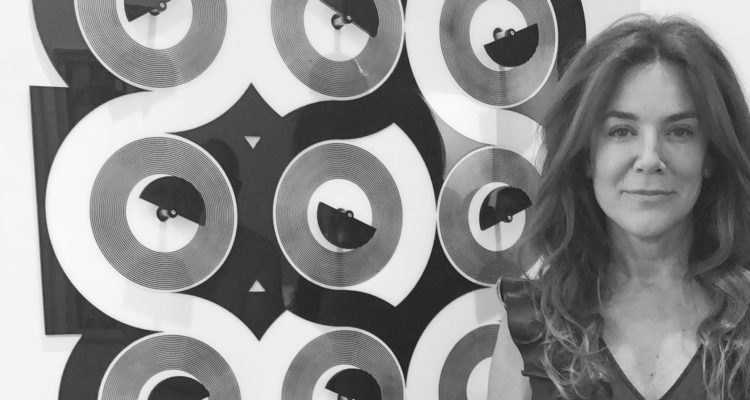“We have to be more united, conscious and supportive than ever.”
Paul Zimmerman in conversation with Mariana Villafane
Paul Zimmerman: Your art is often inspired by geometry and optical effects. How did you develop your interest in this field?
Mariana Villafane: My work is based on geometric abstractions and optical effects because I am interested in the visual representation of movement. Movement as a metaphor of change, transformation and evolution. I came to the conclusion that “Without movement there is no transformation” after experimenting with an old music turntable that has belonged in my childhood to my absent father.I made drawings modifying the turntable nail, those drawings were random and not under my “control”. Beautiful elliptical figures were the result!! It was from there that I became obsessed with geometry and discovered that in a painful way, we can also find beauty and wisdom.
PZ: Your work in various mediums. Which one do you prefer?
MV: I prefer the medium that allows me the best way to express my artistic and personal concerns. I have been working for years in kinetic art developing sculptures, pieces and installations on a large scale. I am a reference of the current kinetic art, and certainly we are not many working in that field. I work with customized technology, I mix robotics and electronics, I invent machines, mobiles.Painting is my specialty and is part of most of my work. Actually, I can say that my works are mainly kinetic pieces, paintings and installations.
But the message is univocal : MOVEMENT
PZ: What is your artistic process? How do you create your work?
MV: For me, artists are first and foremost thinkers. My process focuses on a state of constant thought, study and learning. I am very attentive to what concerns to me to in order to create a poetic metaphor that as a final result will be a plastic expression. I am extremely obsessive about the quality of my work and I am constantly producing new pieces. I research a lot about mechanics and technology in order to make my moving parts that are very complex.
PZ: Where do you find inspiration?
MV: I am very interested in the history of Art. I belong to a very strong tradition that is Geometric Abstraction and Kinetic Art. I research all the artists who worked in that field in the past. I am inspired not only by their “formal” research but also by their existential, sociological and philosophical politics. I think about their searches and concerns in order to compare them with the existing problems.

PZ: Do you have any particular goal in mind when your start a new piece?
MV: An important goal for me is to allow the viewer to get a univocal and accurate reading of my work. The final result of the work and the aesthetic quality is an obsession for me, but it would not serve without the message behind the pieces.
PZ: How would you describe yourself as an artist?
MV: As an artist I consider myself very integral, curious and restless. I like to cover all possible aspects, I like to investigate materials, mechanisms. I like crossovers between different disciplines, literature, philosophy and poetry. I am an observant, studious and very reflective artist, although intuition and sensitivity are also part of my work.
PZ: Which artists are you most influenced by?
MV: When I began to investigate MOVEMENT the first artist who influenced me the most was Marcel Duchamp. Specifically his “Rotorelief” of 1920’s… Those eccentric circular figures that Duchamp made rotate on a turntable !!!!!
Then I was fascinated by Max Bill and his research on rotational movement and beauty. Jesus Rafael Soto, Vardanega and the incredible Martha Boto and Maria Freire have also influenced my work.
PZ: What does art mean to you?
MV: Art is SUBSTANCE. It is a field where everything is possible. It is the way to see ourselves, others and ourselves in others. It is to reflect and understand ourselves, to share humanity.
PZ: What are you working on now?
MV: I am currently working on a series of kinetic pieces and paintings called [IM]PERCEPTION, based on a study I did on Aldous Huxley’s essay “The doors of perception” where Huxley investigates what happens when we alter the senses. According to William Blake’s phrase that inspires the essay, altering the senses would allow us to access the infinite, the energy and the essence of all things. Based on that reading (which I recommend) I developed a very specific color palette (which was not easy for me since I worked for many years in black and white). This palette is very special, with unique colors and very personal. The kinetic works of this series are called “Synchromatisms” and are the most complex I have developed so far. It has moving pieces mirrored in colors, generating optical effects with the background, psychedelic, also reflect the lights of the environment and the image of the viewer.
PZ: How does the pandemic influence your work and sensibility?
MV: `I am one of those who try to bring out the good in adverse situations. Personally, the pandemic forced me to be in one place and I had to cancel exhibitions in different places in the world. That made me even more productive and focused. I believe that the pandemic gave us a conscious vision that we are a system, that we function in interaction and that everything, absolutely everything, modifies others.
We have to be more united, conscious and supportive than ever.
